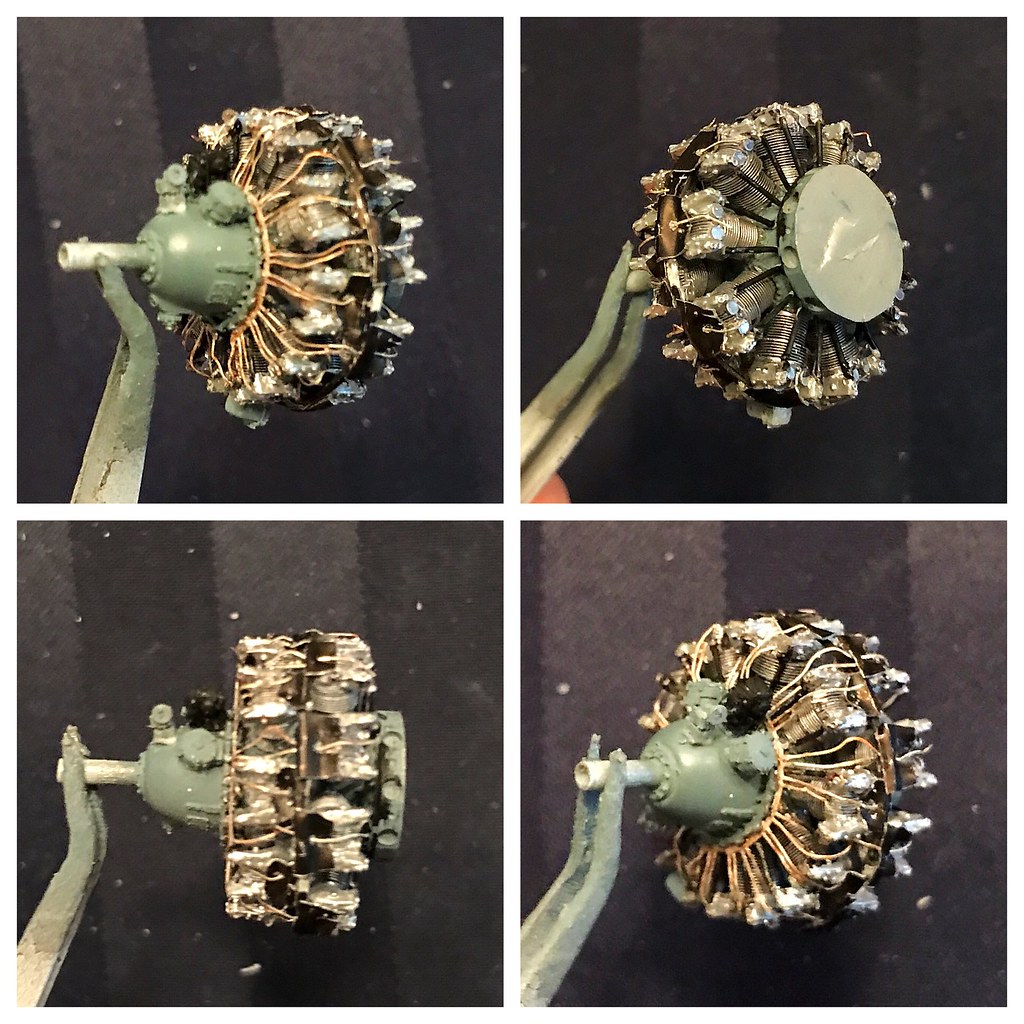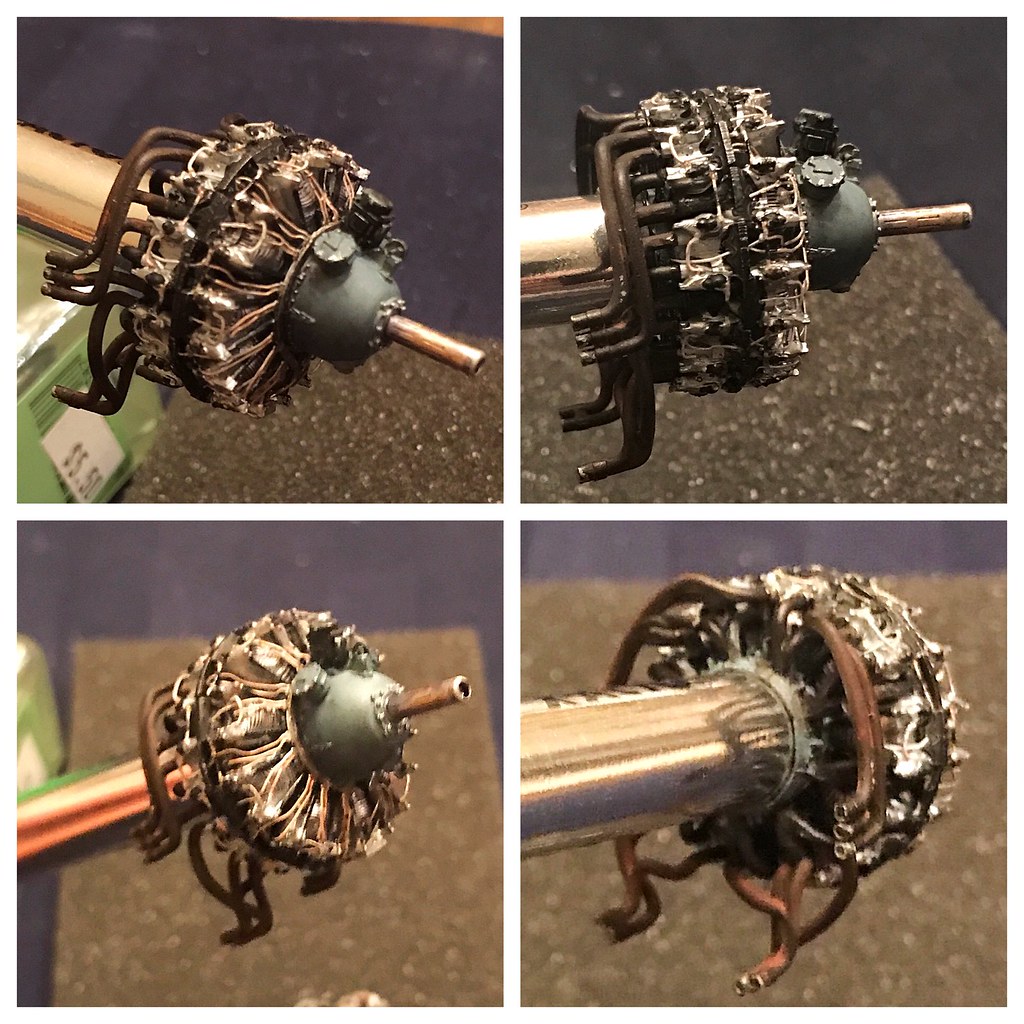This is a little side project I started doing which I thought I'd share here. I won't be starting my Hellcat until December, but I have a good feeling that I will be busier than I'd prefer. So I decided to start the engine now to keep from having to rush later. I will be using Eduard's Brassin R-2800 for that build. Everything I've seen about this resin engine looks like a delight to build and I'm happy to finally get to try it. I also picked up Vector's R-2800 to drop into the Corsair that will follow and decided to build them together to see how the two matched up. This is all rather straight forward so I'll just jump into it. =]
 Untitled by Britt Vallot, on Flickr
Untitled by Britt Vallot, on Flickr
Here are the two sets of parts. Eduard's on the left and Vector on the right. The instructions for Vector are typical of those guys and seem to expect an experienced modeler who knows the engine well already (which I find kinda hard to argue with). One thing to point out is that the other doubled up parts are distributors for other blocks. It's not labeled and you wouldn't know it if you hadn't come across it in photo references. The Eduard's instructions are entirely opposite and read as well as one could ask. They honestly couldn't have made a better set of instructions. I don't have a picture of them here as it's four pages and I didn't feel it necessary. If you've purchased Eduard AM stuff in the past, then you likely already know. =] Both kits give an accurate interpretation of the P&W R-2800-10 engine. I lean a little bit to the Vector side for the cylinders, but for everything else I think the tie breaker goes to Eduard. The propeller reduction box is a little narrow on the Vector mold. Eduard's seems more accurate. Most kit manufactuers seem to go too narrow with this part I've noticed. I'd still place Vector ahead of the OOB builds though. It is noticably narrower compared to Eduard's but still quite sharp. The data plate is molded onto the Vector prop box and is absent on the Eduard. I used lead foil to represent it. You'll see this later on.
Moving on to primer and some paint.
 Untitled by Britt Vallot, on Flickr
Untitled by Britt Vallot, on Flickr
Eduard's Brassin engine is top and right while Vector is the bottom two left. Primer is Alclad's grey primer and the metal base color is Dark Aluminum. The intake manifold is done in Alclad's Exhaust Manifold as I find it a good color to show the heat and wear that this part still sees. The actual exhaust manifold that Eduard has molded has received the same color. This part is quite beautiful and better than I'd probably ever hope to scratch out. I'll be putting a couple other coats of rust colors to better represent this.
 Untitled by Britt Vallot, on Flickr
Untitled by Britt Vallot, on Flickr
Eduard's Twin Wasp. As the name suggests, there is some PE that comes along with this to dress it up. In the past, I shied away from the PE wiring harness as I thought it to be too flat. Honestly though I don't feel it to be such a big deal here. Luckily, Eduard has allow some options to build with and offers two wiring harnesses and I chose to use the other for the Vector build in an effort to save time. With a little teasing and CA it goes on just fine. Eduard makes this build very quick and it is well engineered.
 Untitled by Britt Vallot, on Flickr
Untitled by Britt Vallot, on Flickr
Vector's Twin Wasp. This one takes a little bit of knowing what you're doing. I use a very strong white glue which is a little forgiving at first to allow everything to be put together and then tightened up as needed where something may be out of allignment. Piston rods are plastic rod from Evergreen. Number 218 I believe. Kind of speaks for itself.
 Untitled by Britt Vallot, on Flickr
Untitled by Britt Vallot, on Flickr
There's one thing the Vector kit didn't include and that's the ring mounted harness for the cables going to the pistons. Not too difficult to scratch out though. Some lead foil is used to make up the difference.
 Untitled by Britt Vallot, on Flickr
Untitled by Britt Vallot, on Flickr
 Untitled by Britt Vallot, on Flickr
Untitled by Britt Vallot, on Flickr
Vector on the left and Eduard on the right here. This is a good set up to see what you're getting. The oil rocker box at the bottom on the Vector engine is an incorrect part. I put that on there to see it's profile and if I might possibly reshape and use it as such...just to note. More or less looking at two solid engines though.
Here's a little bit more going on after all of the intercylinder oil drains and connections and a bit of weathering.
Vector
 Untitled by Britt Vallot, on Flickr
Untitled by Britt Vallot, on Flickr
Eduard
 Untitled by Britt Vallot, on Flickr
Untitled by Britt Vallot, on Flickr
 Untitled by Britt Vallot, on Flickr
Untitled by Britt Vallot, on Flickr
The prop shaft is painted in Pale Burnt Metal from Alclad. The Detailer in Black to weather much of this. A little Tamiya Smoke was airbrushed onto all of this as well. I have just a little bit more of some bells and whistles to add...oil slump lines and the like are fiddly parts that get bent and broke so I add them last. Then, there's just a coat of Alclad's Light Sheen and some last bit of weathering for my Corsair engine and that'll be a wrap. =]
I hope this serves as something fun and informative to other modelers out there looking at all the pretty AM stuff, but hesitate to pull the trigger like me. Any comments or suggestions or especially questions are all welcomed.
Be back with more.